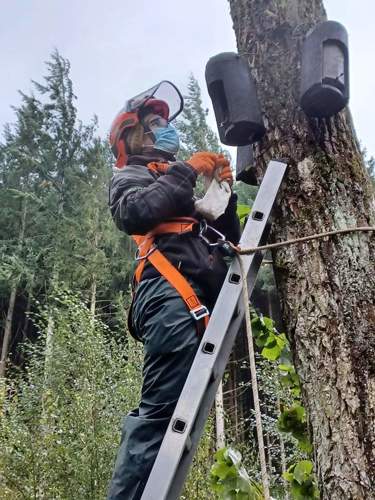Bats in our forests

Did you know that Scotland is home to ten of the 17 bat species living and breeding in the UK?
Some of the biggest threats to bats come from habitat destruction and fragmentation such as roads, railway lines and other obstacles that limit their movement. Urban developments including road building, modern farming practices with the use of pesticides and the loss of wetlands, as well as some forestry operations, can all contribute to less foraging habitat and possible roost sites for this species.
Even the loss of hedgerows can impact bats — they like to follow linear features like hedgerows or woodland edges when moving from roost to foraging sites. A reduction in these travel corridors can limit their movement and may expose them to higher levels of predation.
Bat boxes
Bats use their roosts to shelter and raise young.
Bat boxes provide safe roosting spaces for bats, particularly in areas where natural roosts such as tree cavities are hard to find. This can be the case in some commercial forestry plantations where there are lots of the same type of tree at the same stage in its life cycle. These can provide less in the way of natural features for bats to use for shelter.
This is why we often have bat boxes in our forests.
Through the twentieth century we developed very efficient plantations of single species that could be harvested cost-effectively. Planting the same species together became standard practice. Now, we realise that there are downsides. A warming climate has made some species vulnerable to diseases and pests, and we know that a diversity of species makes for better habitats and better places to visit. By adapting the composition of our forests and including more variety we can make our forests more likely to meet our needs in future.

We currently have ten bat box schemes in various forests in the Scottish Borders from Ladyurd in the north to Newcastleton in the south. Bat boxes are put in places where they are likely to attract the most bats, such as along riparian (riverside) corridors as well as near ponds and wetlands. The schemes usually have between eight to 12 boxes which are spread out along the habitat corridor.
All bat species and their roosts are legally protected. It's an offence to deliberately or recklessly disturb, injure or kill bats, as well as damage or destroy their roosts.
What bats can tell us
Bats are highly sensitive to change, whether it be a reduction of hedgerows or fewer bugs due to pesticides. Because of this, they’re considered ecological indicator species for habitat quality and biodiversity change. Basically, they can tell us about the state of the environment around them.
The bat boxes in our forests are checked annually, by qualified and licensed environmental staff. These records, going back over many years, provide us with trends that could shed light on the impacts of habitat and climate change. They provide useful information when we are making decisions about how we look after Scotland's national forests and land.